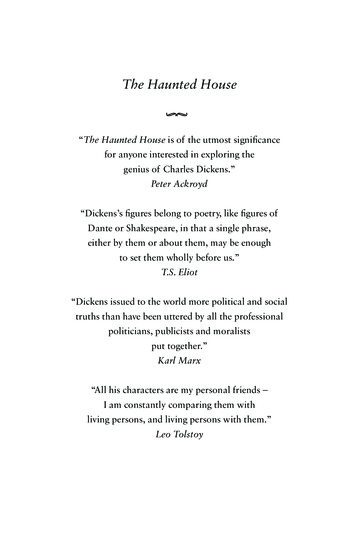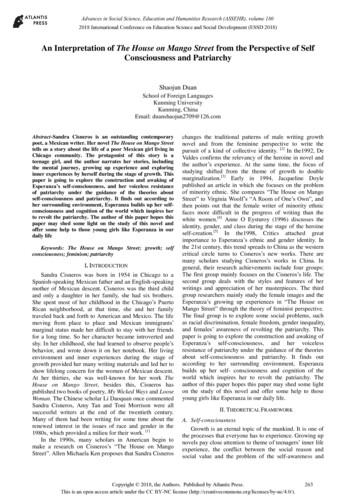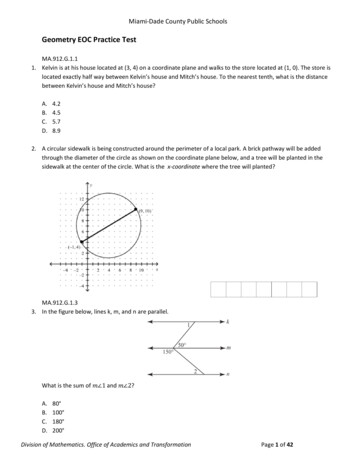
Transcription
“From House to Home”:The Structure of a Soul Journey in Christina Rossetti’s Devotional WritingA ThesisSubmitted to the Faculty of Graduate Studies and ResearchIn Partial Fulfillment of the RequirementsFor the Degree ofMaster of ArtsinEnglishUniversity of ReginabyLara Dawn StoudtRegina, SaskatchewanDecember 2016 2016: L. D. Stoudt
UNIVERSITY OF REGINAFACULTY OF GRADUATE STUDIES AND RESEARCHSUPERVISORY AND EXAMINING COMMITTEELara Dawn Stoudt, candidate for the degree of Master of Arts in English, has presented athesis titled, 'From House to Home': The Structure of a Soul Journey in ChristinaRossetti's Devotional Writing, in an oral examination held on November 30, 2016. Thefollowing committee members have found the thesis acceptable in form and content, andthat the candidate demonstrated satisfactory knowledge of the subject material.External Examiner:*Dr. Karen Dieleman, Trinity Christian CollegeSupervisor:Dr. Susan Johnston, Department of EnglishCommittee Member:Dr. Franz Volker Greifenhagen, Department of ReligiousStudiesCommittee Member:Dr. Christopher Bundock, Department of EnglishChair of Defense:Dr. Eldon Soifer, Department of Philosophy*Via Skype
iAbstractThis thesis examines how Christina Rossetti uses a specific narrative structure Iterm the soul journey, to help her readers navigate the chaos of an ever-changing socialand religious culture of Victorian England. Foundational to my analysis of her writing isthe literary influence of Dante Alighieri, John Bunyan, and Alfred Lord Tennyson;specifically how their writing demonstrates the spiral structure of the soul journey. Alsovital to this study is Rossetti’s devotion to Anglo-Catholic liturgical practices derivingfrom the Oxford Movement of the 1830s and 1840s in England. The leaders of theOxford Movement, or Tractarians, sought reform of the Church of England. As part oftheir mandate for reform, they called for a renewed emphasis on the Sacraments,including the Sacrament of the Eucharist. Rossetti, who regularly attended ChristChurch, a parish at the centre of the Oxford Movement, was exposed early in her life tothe teachings of the Tractarians; thus, her own writing shares elements of Tractarianthought. This thesis will establish that patterns of worship in the Anglo-Catholic liturgy,including the Communion service and liturgical calendar, mirror the spiral structure ofthe soul journey. First, this narrative structure is used to examine overall patterns inRossetti’s devotional writing and then applied to the narrative poem, “From House toHome.” Second, the soul journey structure is used to explore the themes of hope andhospitality in Rossetti’s writing. Details of Anglo-Catholic liturgy, with a focus on thesacrament of the Eucharist and Rossetti’s own devotional practices, will be applied to aclose reading of “Goblin Market” and “A Better Resurrection.” I conclude with an indepth study of Rossetti’s devotional prose work Time Flies and I reveal how Rossettireworks the repetitive and mechanized conventions of industrial time to navigate the souljourney through liturgical time as preparation for the afterlife.
iiAcknowledgmentsI would first like to thank my supervisor, Dr. Susan Johnston, who has givengenerously of her time and her wisdom to bring this paper to completion. Dr. Johnstonleads with her intellect because she expertly guided me through the labyrinth of thisimmense project, but, most importantly, she leads with her heart because, with kindnessand care, she has sustained me through some difficult days, always encouraging me tolook forward and up. She has supported my project from its conception, providing thecritical framework I needed and also the space I required to find my own voice. Also, theDepartment of English at the University of Regina has been instrumental to this project’scompletion. From informal conversations with colleagues and faculty to the formaladvising from Dr. Jeanne Shami in the proposal stage, I could not ask for a moresupportive academic community of which to be a part. Dr. Troni Grande, DepartmentHead, and Dr. Susan Johnston, Graduate Chair, work to foster a strong community oflearners who encourage and support one another and it is in that spirit of community thatI have thrived throughout my graduate work. Thank you also to my committee, Dr. ChrisBundock and Dr. Volker Greifenhagen, and to my external examiner, Dr. KarenDieleman, for your generous gift of time and expertise. It is with their excellence inattention to detail and their specialized knowledge that I have brought this thesistogether.Over the course of my graduate studies, I have been fortunate to receive financialsupport from Graduate Studies and Research in the form of a Graduate Research Awardand Graduate Teaching Assistantship. Furthermore, this project was supported by aSocial Sciences and Humanities Research Grant, the Dr. Morris Shumiatcher GraduateScholarship in English, and the Saskatchewan Innovation and Opportunity GraduateScholarship. These scholarships and grants provided the support I needed to focus on my
iiithesis and I am grateful for these organizations and the estate of Dr. Morris Shumiatcher.DedicationI dedicate this thesis and the journey to get here to my friend and mentor, GloriaDaum, who has weaved into my life God’s wisdom and love. Also, to my friends andfamily who have soul-journeyed with me through all the spirals down and spirals up.To my husband, Jason, thank you for your love, friendship, and support. And to mysons, William, Benjamin, and Josiah, every word is for you because you give my lifetrue purpose and bring true joy to my heart.
ivTable of ContentsAbstract . . . . . . . . . . . . . . . . . . . . . . . . . . . . . . . . . . . . . . . . . . . . . . . . . . . . . . . . . . . . . . . iAcknowledgments . . . . . . . . . . . . . . . . . . . . . . . . . . . . . . . . . . . . . . . . . . . . . . . . . . . . . . iiDedication . . . . . . . . . . . . . . . . . . . . . . . . . . . . . . . . . . . . . . . . . . . . . . . . . . . . . . . . . . . . iiiTable of Contents . . . . . . . . . . . . . . . . . . . . . . . . . . . . . . . . . . . . . . . . . . . . . . . . . . . . . . . ivCHAPTER ONE: Introduction . . . . . . . . . . . . . . . . . . . . . . . . . . . . . . . . . . . . . . . . . . . 1CHAPTER TWO: “From House to Home”: The Structure of a Soul Journey . . . .172.1 The Definition of a Soul Journey . . . . . . . . . . . . . . . . . . . . . . . . . . . . . . . . . .172.2 The Shape and Direction of a Soul Journey . . . . . . . . . . . . . . . . . . . . . . . . . 222.3 The Soul Journey Structure in Dante’s The Divine Comedy . . . . . . . . . . . . 232.4 The Soul Journey Structure in John Bunyan’s The Pilgrim’s Progress . . . . 262.5 The Soul Journey Structure in Tennyson’s In Memoriam . . . . . . . . . . . . . . 282.6 The Soul Journey Structure in Rossetti’s Devotional Writing . . . . . . . . . . . 302.7 The Soul Journey in “From House to Home” . . . . . . . . . . . . . . . . . . . . . . . . 35CHAPTER THREE: “Give Us This Day Our Daily Bread”: Hope and Hospitalityin Christina Rossetti’s Devotional Writing . . . . . . . . . . . . . . 493.1 Introduction: Hope and Hospitality . . . . . . . . . . . . . . . . . . . . . . . . . . . . . . . 493.2 Liturgy and The Soul Journey . . . . . . . . . . . . . . . . . . . . . . . . . . . . . . . . . . . . 573.3 Communion and The Soul Journey . . . . . . . . . . . . . . . . . . . . . . . . . . . . . . . . 623.4 The Liturgy and Community . . . . . . . . . . . . . . . . . . . . . . . . . . . . . . . . . . . . . 70CHAPTER FOUR: “On Earth as it is in Heaven”: Keeping Time with the DivineRhythm in Christina Rossetti's Daily Devotional Time Flies . . . . .744.1 Introduction . . . . . . . . . . . . . . . . . . . . . . . . . . . . . . . . . . . . . . . . . . . . . . . . . . 744.2 Living out the Liturgical Year in Time Flies . . . . . . . . . . . . . . . . . . . . . . . . . 754.3 Liturgical Practice as Preparation for the Afterlife . . . . . . . . . . . . . . . . . . . . 954.4 Conclusion . . . . . . . . . . . . . . . . . . . . . . . . . . . . . . . . . . . . . . . . . . . . . . . . . . 103Works Cited and Consulted . . . . . . . . . . . . . . . . . . . . . . . . . . . . . . . . . . . . . . . . . . . . 104
1CHAPTER ONE: IntroductionChristina Georgina Rossetti, born December 5, 1830, began her life in London,England during a crucial transitional decade in British history, a decade marked by socialand political reform, initially through the First Reform Bill of 18321 and the abolition ofslavery in 1833, and, at its close, by the coronation of a new, young monarch, QueenVictoria, who was just eighteen when she was crowned in 1837.2 During QueenVictoria’s 63 year reign, Victorians would experience full immersion into the industrialage, driven by the steam engine, which would infiltrate most facets of industry andtransportation and help “transform an entire economy and way of life” (Black et al.LXV).3 Victorian culture would also see a transition into a new “mass visual culture”(LXI), which was manifested in several popular cultural developments including “publicamusements, popular shows, traveling exhibitions, circuses, sporting events, holidayresorts, and public gardens” (LXII) and new technologies such as the cinema, thedaguerreotype, and the photograph. The popularity of this new visual culture was1This was the first of three Reform Bills in the nineteenth century which sought toexpand male suffrage in England.2Queen Victoria would reign for 63 years until her death in 1901. The literary periodknown as the Victorian period is aptly named for Queen Victoria’s reign. Literaryhistorians often see the 1830s as the end of the Romantic era and the beginning of a newliterary period, the Victorian Age; therefore, the early works of this burgeoning new ageboth reflected and rejected their literary predecessors, the Romantics, including WilliamWordsworth, Samuel Coleridge, William Blake, Lord Byron, and John Keats. SeeRichard D. Altick’s book Victorian People and Ideas for a larger discussion on thetransitional 1830s, particularly his chapter “Romantic Heritage and Regency Twilight.”3Black et al. note that the steam engine was a “symbol of power both on land and sea. . .Steam engines were adapted for use in the production of coal, textiles, heavy metals, andprinting presses, thus becoming indispensable to Britain’s industrial growth [and]steamships powered the British Empire, with several major shipping lines. . . [Also,]steam locomotives epitomized the coming of the Victorian era” (LXV-LXVI).
2propelled by a rising middle class that had more disposable income to enjoy leisure andrecreational activities. The Great Exhibition of 1851 would come to epitomize this shiftin Victorian culture.4 Rossetti would also witness and contribute to the expansion of printculture, which included a rise in popularity of prose and non-fiction works and also anincrease in the number of periodicals.5 Although mass print culture would be dominatedby male voices, women writers, like Rossetti, found an outlet and an audience for theirown unique Victorian voices.In the years that followed, the Church of England faced its own calls for reform,responding, in part, to challenges to scripture as an authority for scientific thought. Inparticular, scientific texts like Charles Lyell’s Principles of Geology (1830-33), and afew decades later, Charles Darwin’s On the Origin of Species (1859) and The Descent ofMan (1871) called into question the age of the earth and the origins of humankind as toldin Genesis. There were also opposing religious viewpoints within the church itself,including, but not limited to, the Oxford Movement (the High Church), the Evangelicals(the Low Church), and the Broad Church or Latitudinarian Church.6 At the beginning of4The Great Exhibition of 1851 was “the first world’s fair, [and] officially called theGreat Exhibition of the Works of Industry of All Nations but familiarly known then andever since as the Crystal Palace” (Altick 11). The exhibitors were “housed in the firstprefabricated public housing in history, a vast construction of iron and glass set inLondon’s Hyde Park” (11). The exhibition featured displays from Britain and othernations, which “reflected the success of Britain’s new free-trade policy” (11).5Popular periodicals, such as the Edinburgh Review, Blackwood’s Magazine, theQuarterly Review, Fraser’s Magazine, and the Athenaeum brought to the public attention“the day’s key issues, [including] the latest scientific developments to religiouscontroversies, . . . aesthetic developments, [and] social values and mores” (Black et. alLXXVIII).6To clarify, Altick says, “In the Victorian period ‘Latitudinarian’ was usedsynonymously with ‘Broad Church,’ and in most people’s usage the more general word‘liberal,’ in a religious context, meant ‘Broad Church’ also” (207). According to Altick,the Broad Church “constituted a kind of rudimentary ecumenical movement, seeking tobring various Christian denominations together on common grounds of belief” (207).The Evangelicals or Low Church included a number of Protestant denominations,including Methodists, Presbyterians, The Salvation Army, Baptists, and the PlymouthBrethren. In general, the Evangelicals stressed the “importance of an individual’s
3the Victorian period, despite the dissenting voices of the Evangelicals, the establishedAnglican church (mostly Latitudinarians) maintained political control. As Altick notes,the “bishops, nearly all of whom were connected with the aristocracy by blood, marriage,or patronage. . . functioned mainly as a powerful bloc in the House of Lords . . . theysupported Tory polices down the line” (204). Although the established church wouldmaintain “a powerful entity throughout the Victorian era” (Black et al. LVI), “internalcorruption7 and the failure to serve a changing society” (204) would slowly erode theChurch of England’s influence on the general public.8Rossetti’s family was also known for its own complications and contradictoryviewpoints. Christina’s father, Gabriele, was an Italian immigrant who came to Londonin 1824 after fleeing Italy as a “hunted revolutionary” (Weintraub 1). Gabriele was aDante scholar and Italian teacher. He married Christina’s mother, Frances, the daughterof Gaetano Polidori (another Italian teacher) and Frances Pierce (an Anglo-Saxongoverness). The Rossetti children (Maria, Christina, Dante, and William) inherited a richliterary and scholarly education from their father Gabriele and grandfather, GaetanoPolidori. Frances Rossetti provided the religious education for her children and theywere regularly taken to church. Christ Church on Albany Street, a predominant church inrelationship with God, of prudence and temperance, of conversion, of missionary work,and of humanitarian activism” (Black et. al LVI). The High Church or the OxfordMovement, formed, in part, as a “reaction to the Evangelical movement, led by Oxfordtheologians John Henry Newman, John Keble, and Edward Pusey” (Black et. al LVII).Proponents of the Oxford Movement, “celebrated aesthetic elements of worship, [and]advocated an increased emphasis on religious ritual and a strict observance of clericalhierarchy within the Anglican communion” (LVII). Newman would later convert to theCatholic faith in 1845, which “spelled the end of the Oxford Movement [and ushered ] ina significant Catholic revival” (LVII).7As an example of this internal corruption, Altick asserts that the “bishops andarchbishops lived in almost regal splendor, [while the] ordinary clergymen were on theedge of starvation” (206).8Also contributing to the instability in the established church was the “working-classattack” or “anti-clericalism,” which helped fuel the French Revolution (Altick 205).
4the Oxford Movement, was Rossetti’s home church from1843-18769 and from 1876 toher death in 1894, she attended another Christ Church (Woburn Square) near her homeon Torrington Place. Christina and Maria would uphold their mother’s religiousdevotion. Dante and William, more “dutiful than devotional” (Weintraub 5), wouldbecome critical of the church and eventually drift away from regular attendance. Thereligious and social tensions within the Rossetti household and in Victorian society ingeneral, along with the variety of literary, philosophical, and scientific texts thatinfluenced her, provided fertile ground for Rossetti’s writing.10Rossetti’s response to the waves of change in her social and religiousenvironment would be to write poetry and prose that exposed the struggles and thetriumphs of the spiritual journey. Rossetti’s writing is marked with the anxieties, eventhe sufferings, of a Victorian woman in a volatile time. Yet, even when the scripturalfoundation of her church is questioned, Rossetti’s voice of faith remains resolute.Rossetti demonstrated in her own life a devotion to a public and private liturgicalpractice and her habits are echoed in over 50 years of religious writings.11 As my thesis9As Raymond Chapman notes, the Anglo-Catholic teachings of Christ Church onAlbany Street were a natural fit for Rossetti, reflecting her own family’s Anglican andCatholic background. As a “product of a mixed family, more Italian than English,”Chapman says, “[her] maternal grandmother had dealt with religious division by havingher sons brought up as Roman Catholics and her daughters as Anglicans” (170).10Mary Arseneau notes that Christina Rossetti “read in English, Italian, German, andFrench: knew Italian poets better than most scholars studying her poetry today; and readthe important poets, novelists, and critics of her century including Coleridge, Shelley,Keats, Scott, Dickens, Carlyle, Ruskin, L.E.L. (Letitia Elizabeth Landon), BarrettBrowning, Browning, Tennyson, and many more. [She also read] periodicals, includingAthenaeum, Macmillan’s Magazine, the Saturday Review, Blackwood’s, and theEdinburgh Review. As an adult she approached Dante, Petrarch, Boccaccio, and Spenseras a scholar, spending innumerable afternoons at the British Museum. . . [She] publishedmore than two thousand pages in a range of works whose focus was not primarily poeticor creative but rather biographical, critical, devotional, or exegetical” (“Introduction”xv).11One of Rossetti’s earliest recorded poems, a birthday gift for her mother, was writtenwhen she was just eleven (Marsh 33). Rossetti would write and publish up until her deathon December 29, 1894.
5will show, Rossetti will answer Victorian religious doubt and the industrialization ofclock-time with volumes of devotional poetry and prose designed to direct her readersback to the rhythms of divine grace through an emphasis on liturgical rituals and theliturgical calendar.The critical response to Rossetti’s devotional writing since its reception has beenvaried, not surprisingly given the complexity of her family, social, and religious milieu.An 1876 review of Rossetti’s poetry exclaimed: “Miss Rossetti has set up a littledevotional shrine here and there throughout the volume, where we find her on her knees,with a strong faith, a deep sense of spiritual needs . . . As she sinks her poetry rises”(“Christina Rossetti’s Poems” The Catholic World 127). Similarly, in 1904, Ford MadoxHueffer asserted that her poetry is “a prayer, an adoration of the Saviour, a fear of theAlmighty, a craving for pardon and for rest” (397). In a 1931 biography, Eleanor WalterThomas explains that “[Rossetti] accepted the God and the doctrines of Christianity asrevealed in the Bible and the Book of Common Prayer and interpreted by the Church ofEngland” (192). With this in mind, Thomas suggests that Rossetti’s devotional poemsand prose works were reflections of Rossetti’s “flight from the finite to the Infinite. . .her quest for God” (190). Others, however, saw Rossetti as a melancholy, repressedwoman and her poetry as an expression of mental illness and suffering. Even her ownbrother William Michael Rossetti prefaced his anthology of her poetry by saying, “Overscrupulosity made Christina Rossetti shut up her mind to almost all things save the Bibleand the admonitions and ministrations of priests . . . Her temperament and character,naturally warm and free, become a fountain sealed” (lxviii).12 Sandra M. Gilbert and12Notably, William Rossetti’s view of Christina’s writing in his “Memoir” is much morenuanced than this simple statement regarding her “over-scrupulous” ways. As much ashe critiqued her religious close-mindedness, he also praised her steadfast faith. And,importantly, William did not think that her religion in any way diminished her poetictalent; for instance, he says, “Impulse and élan were checked, both in act and in writing,
6Susan Gubar,13 examples of the psycho-social feminist school of thought that stillinfluences Rossetti criticism today, proclaim that Rossetti’s “female poet-speaker[s]must discover . . . that for the woman poet only renunciation, even anguish, can be asuitable source of song” (572). They ably highlight a particular tone and voice revealedin some of Rossetti’s poetry; nonetheless, their vision is narrow as it is based only on afew poems in Rossetti’s first volume of poetry, Goblin Market and Other Poems (1862).Yet, despite the myopic nature of their analysis, feminist critics, like Gilbert and Gubar,were the first to reintroduce Victorian women writers, like Rossetti, to the scholarlyconversation and offer different ways to look at their writing.The conversation that began with the early feminist critics is important becausetheir perspective allows for a more nuanced view of how Rossetti’s religious practicesimpacted her writing. One particular book, Lynda Palazzo’s Christina Rossetti’sFeminist Theology (2002), advocates for Rossetti’s “feminist theology” that attempts tonavigate the “fundamentally male religion” (2). Palazzo’s analysis of Rossetti’s narrativepoem “Goblin Market” as an example of “positive female spirituality” (7) has beeninstrumental in my own analysis of Rossetti’s “Goblin Market.” Importantly, Palazzo,like the feminist critics before her, argues that Rossetti’s writing (in particular her earlypoems) clearly demonstrates her struggle with Tractarian thought on female sexualityand the female body (8).14 My inquiry into Rossetti’s devotional writing arises out ofPalazzo’s observation of the female body’s struggle through male-dominated religiousdoctrine that oppressed the female body. However, my analysis will look at sexuality andbut the most extreme spontaneity in poetic performance always remained” (The PoeticalWorks of Christina Georgina Rossetti: with Memoir and Notes lxviii).13Gilbert and Gubar wrote the influential book The Madwoman in the Attic: The WomanWriter and the Nineteenth-century Literary Imagination (1979).14One of the issues that Palazzo takes up in her analysis of Rossetti’s early poems is theTractarian Edward Pusey’s teachings of renunciation. Palazzo argues that some ofRossetti’s poems demonstrate her own struggle against “adolescent girl’s longings, halfsexual, half-spiritual” (6) and how she directs these desires “towards martyrdom” (6).
7other bodily experiences in Rossetti’s writing as not in conflict with her religiouspractice, but essential to the way Rossetti experienced her religion.15Many critics have focused on Rossetti’s religious devotion. Notably, AnthonyHarrison, in his 1988 book, Christina Rossetti in Context, is harsh with her previouscritics and states that “Rossetti has suffered severely from the critical approaches ofbiographical scholars who have frequently read her verse to lay bare the nature of herunfulfilled passions or to discover the identity of her innominate lover” (2).16 Harrisontargets specific feminist scholarship, successors to Gilbert and Gubar, that saw Rossettieither as a victim of patriarchal oppression or as a subversive woman writer, promotingfeminist ideals. Diane D’Amico in Faith, Gender, and Time (1999) observes Rossetti’simage has changed over the last century from “[a woman] reflecting the values of aVictorian woman of faith. . . [to,] most recently, . . . a highly intelligent woman in apatriarchal society whose poetry reveals both victimization and subversive feminism”(1). D’Amico’s observation may have been true in 1999, but it appears that Rossetticriticism is coming full circle in recognizing that her work reflects the values of anineteenth-century Anglo-Catholic faith. For instance, Dinah Roe’s 2006 book ChristinaRossetti’s Faithful Imagination is careful in acknowledging feminist criticism for15Frederick S. Roden postulates a similar pattern in Rossetti’s writing in his essay “Kissof the Soul.” He argues that given the “revival of interest in incarnational theology [andthat] through the Oxford Movement in the early nineteenth century, the relationshipbetween religion and sexuality, spirituality and gender, began to be re-examined. Inglorifying the beautiful body of Christ in the Real Presence, religious discourse took on amore body-centered voice” (38). Notably, Roden asserts this body-centered religiousdiscourse is not new at all, but echoes the “mystical heritage” (38) of the Anglicanchurch. He notes, as one example, that in the 1840s, Showings of Love by Julian ofNorwich, a fourteenth-century mystic, resurfaced to influence writers like Rossetti (38).16Harrison goes on to suggest that “readings of Christina Rossetti’s works by such criticshave depended on the fallacious assumption that her poetry is written for the most part ina confessional poetic mode. . . [instead, he suggests,] her poems are exploratory,presenting notably different views—from poem to poem and even from one version of apoem to another. . . her aesthetic values often derive from extremely diverse andsometimes ostensibly incompatible literary sources” (2).
8contributing to the promotion of Rossetti’s work and continued reception; however,Roe’s focus is Rossetti’s religious devotion: how her religious practices informed herwriting and the role her writing played in her spirituality.17My analysis of Rossetti’s writing reflects recent scholarship that has called for a“turn to religion” in literary criticism (LaPorte 277), following Ken Jackson and ArthurF. Marotti’s 2004 influential essay “The Turn to Religion in Early Modern EnglishStudies.” Jackson and Marotti assert that a writer’s religion is “certainly a deeppsychological and emotional experience, a core moral commitment, a personally andsocially crucial way of transvaluing human experience and desire, a reality both withinand beyond the phenomenal world” (169). Jackson and Marotti’s focus on Early Modernliterary studies, but the same idea is essential to Victorian literary studies. Religion, tomost Victorians, was formative of the way they thought about and experienced theirsocial environment, as Altick notes in Victorian People and Ideas:The ordinary Victorian had been reared in a culture circumscribed byChristian teaching. In addition to a common literary and argumentativevocabulary, the Bible provided the accepted cosmogony, a considerable partof ancient history, as it was then known and above all the foundations of hismorality. Religion had determined his whole outlook upon life. (203)Altick’s observation of the influence of religion on the ordinary Victorian citizencertainly advocates for a closer look at the role religion plays in a nineteenth-centurywriter’s work, like that of Rossetti. Karen Dieleman’s 2012 book Religious Imaginaries,17For instance, Roe credits Diane D’Amico, Lynda Palazzo and Mary Arseneau for theirwork “in the rediscovery and rehabilitation of Rossetti’s devotional work” (2). She alsocalls for more work to be done to uncover the “role of her religious faith. . . specificallyRossetti’s reading of the Bible” (2). Roe speculates that the “criticism of Rossetti’ssubstantial body of devotional work has historically been hampered by a discomfortabout treating religious writings, particularly by a middle-class, nineteenth-century,single woman, as works of literature” (3).
9which focuses on the writing of Elizabeth Barrett Browning, Christina Rossetti, andAdelaide Procter, agrees with Jackson and Marotti and Altick and adds that differencesin religious practices influence how religious writing “takes particular shape and voicebecause it emerges from Christian religious imaginaries formed—deliberately but also indeeper, unconscious ways—by continual engagement in particular worship andenvironments” (17). In essence, these critics have all recognized that religious practicesare foundational to the way a writer’s imagination is formed. Rossetti, from cradle tograve, through the decades of religious doubt and increasing secularism in VictorianEngland, remained a willing and faithful participant in the Anglo-Catholic faith. Herreligious devotion and also the specifics of her religious practices cannot be ignored orover-simplified when analyzing her writing.Certainly, Rossetti scholarship has begun to recognize the influence of herreligious practices and other religious writers on Rossetti’s writing. For instance, manyRossetti scholars have recognized the influence of her male Oxford Movementcontemporaries.18 Among these theologians, John Keble, who wrote the influential bookThe Christian Year, and John Neale, who reintroduced the patristic teachings in his bookMedieval Preachers and Medieval Preaching, are said by Ludlow to have influencedRossetti’s content and also the form of her devotional writings (Ludlow 30). Althoughthe work of these critics has been a valuable contribution to Rossetti scholarship, fewcritics have yet conducted an in-depth analysis of the relationship of her devotionalwriting to other Christian writings. Among these few, Roe acknowledges the Pre-18For example, Diane D’Amico, David A. Kent and P.G. Stanwood, Frederick S. Roden,Emma Mason, Esther Hu, Krista Lysack, Raymond
UNIVERSITY OF REGINA . FACULTY OF GRADUATE STUDIES AND RESEARCH SUPERVISORY AND EXAMINING COMMITTEE Lara Dawn Stoudt, candidate for the degree of Master of Arts in English, has presented a thesis titled, 'From House to Home': The Structure of a Soul Journey in Christina Rossetti's Devotional Writing, in an oral examination held on November 30, 2016. The











